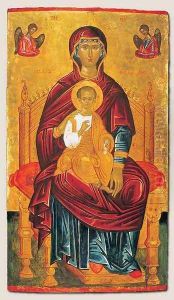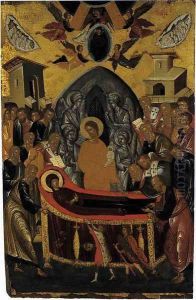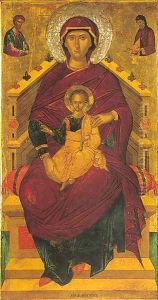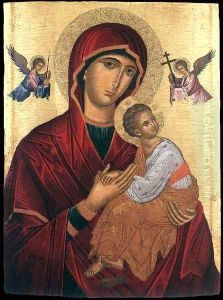Andreas Ritzos Paintings
Andreas Ritzos was a prominent Greek painter, born in 1421 on the island of Crete, which at the time was a vibrant center of post-Byzantine art. The island, under Venetian rule from the 13th to the 17th centuries, became a melting pot of Western and Eastern artistic traditions, fostering a unique school of painting. Ritzos is one of the most celebrated representatives of the Cretan School, which significantly influenced the development of Greek and Italian art during the Renaissance.
Ritzos's work is characterized by its adherence to the Byzantine iconographic tradition, yet it also displays a subtle incorporation of Renaissance elements, particularly in its use of perspective and volume, which were novel techniques at the time. His most famous works are religious icons, which were highly sought after not only in Crete but also in the broader Orthodox Christian world, including Russia, the Balkans, and the Eastern Mediterranean. These icons are notable for their elegance, vivid colors, and the emotional depth of the figures they depict.
Throughout his career, Ritzos remained largely based in Crete, where he contributed significantly to the local artistic community, both as a painter and as a mentor to younger artists. His workshop was one of the most prolific of its time, and it helped perpetuate the Cretan School's influence well into the 16th century, long after Ritzos's death in 1492. The legacy of Andreas Ritzos and his contemporaries laid the groundwork for future generations of Greek artists and helped preserve the Byzantine artistic tradition during a period of significant cultural and political change.
Ritzos's art, deeply rooted in the Orthodox Christian faith, continues to be revered for its spiritual depth and aesthetic beauty. His icons, many of which are still used for worship in churches across the Orthodox world, stand as a testament to the enduring appeal of Byzantine iconography and its capacity to convey complex theological concepts through imagery. Despite the scarcity of documented details about his life, Andreas Ritzos's contribution to the art world is undeniably profound, cementing his place as one of the most important figures in the history of Greek and Byzantine art.



